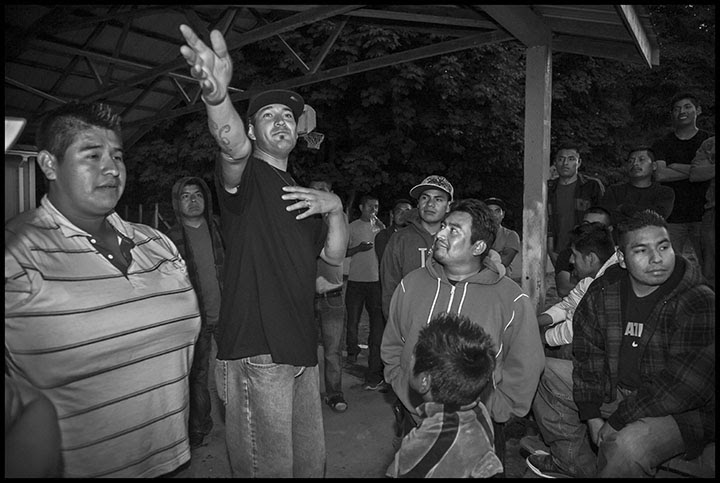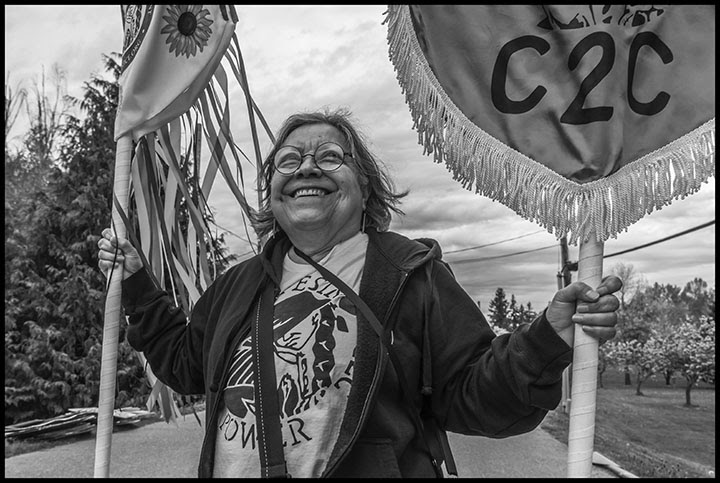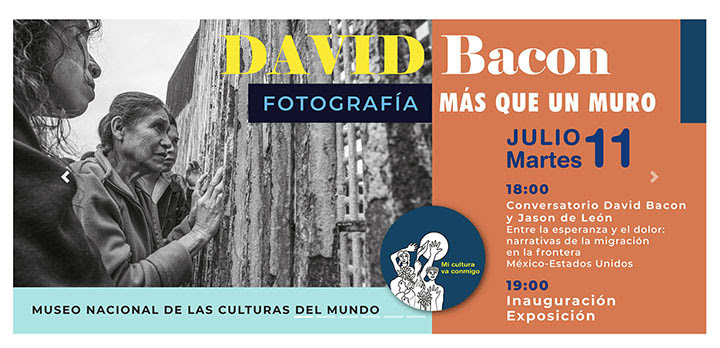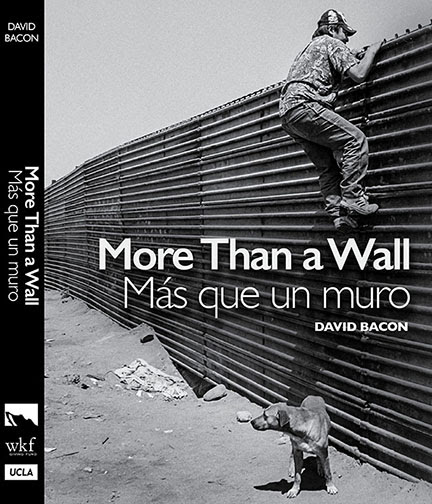
A PATH TO LIBERATION THAT’S STILL EVOLVING
By David Bacon
Civil Eats, 6/29/23
https://civileats.com/2023/06/29/photo-essay-a-cooperative-farms-long-path-to-liberation-for-farmworkers/
https://davidbaconrealitycheck.blogspot.com/2023/06/a-path-to-liberation-thats-still.html

On the Sakuma Brothers farm, over two hundred angry Mixtec and Triqui farmworkers stopped work in 2013, over the firing of a coworker. They needed a spokesperson to present their demands, and Ramon Torres was an unlikely choice. He wasn’t indigenous. He was originally a city boy, raised in Guadalajara and the son of a construction worker. And he didn’t speak the workers’ indigenous languages. But he did speak Spanish, he was a blueberry picker like they were and lived in the labor camp with everyone else. Most important, he’d shown a willingness to stand up to the supervisors.
It was a fortuitous choice. Torres proved to be capable and dedicated. The workers repeatedly voted him president of their strike committee, and later their union, Familias Unidas por la Justicia, over the next four years. Finally, in 2017, they convinced Sakuma Brothers Farms to sign a pioneering collective bargaining agreement. Torres helped bargain the contract, and is still president of their union.
Two years into the bitter struggle Torres was fired. He tried to eke out a living on other farmworker jobs in the area, at the same time spending countless hours strategizing with the Sakuma workers. Then he made another unlikely choice. He became the lead organizer of the first farmworker-based farming co-operative in the Pacific Northwest.

He and his compañeras and compañeros named their co-op Tierra y Libertad (Land and Freedom) – the rallying cry of the Magonistas in Mexico’s rural revolution of 1910-20. They chose the face of Emiliano Zapata, the campesino revolutionary, as their symbol for their banner and the labels of their produce.
Torres was convinced to make the decision by Rosalinda Guillen, founder of Community2Community, a women-led advocacy and organizing center in rural Skagit and Whatcom Counties, two hours north of Seattle. Guillen had long experience helping farmworkers organize unions, and Community2Community organized the support base for the Sakuma workers. The new co-op started as a C2C project.
Torres says that the co-op idea grew out of the fight to get the union organized, and to change the conditions for Sakuma workers. At the beginning, many weren’t convinced that a union contract would change their conditions. «They kept talking about needing another route, and Rosalinda talked with us about a women’s co-op she’d formed earlier. So, workers decided to set one up.»
There were many discussions. C2C organized trainings in co-operative principles, which are still ongoing, eight years later. «Nevertheless, only a few workers actually decided to participate,» Torres remembers. «It was very hard to convince them. They’d ask, who’s going to give me a paycheck? Many thought they’d have to put in money they didn’t have. The reality was that we had nothing, no place even to begin planting. We really didn’t know if we could do it or not.»

Torres and a group from the new union rented their first small piece of land near the Canadian border. «Twelve of us were committed to it, but the money didn’t come in the way we were hoping,» he says. The time commitment was more than most workers could sustain. In the training sessions someone would always be missing. To get to the land from Mt. Vernon, where most lived, was a 45 minute drive.
«People were putting in 10-hour days,» Torres recalls. «They’d arrive at the co-op at 5 in the afternoon, put in an hour and a half, and then have to drive back. In those years, before the union contract, people would go to work at another farm for a few hours after working at Sakuma, because pay was so low they needed the money to survive. So, they had to choose between working that extra job or coming to the co-op. Each day we might get two or three workers, and then the next day two different ones. The weekends were even harder. Saturday is a work day, and Sunday is the day for everything for the family – washing clothes, buying food, all the rest.»
Finally, only 3 remained of the original 12. And after fixing the farm up, breathing new life into its rows of red raspberries and putting up a greenhouse, the owner wanted it back. It was a blow, but they found another piece of land near Sedro Wooley. That was even further away. Finally, they found the 75 acres where the co-op farms today. It’s still a long drive from Mt. Vernon, but the co-op hopes to eventually buy it.
The co-op’s fortunes began to rise when the union contract was finally signed in 2017. The income of Sakuma workers rose dramatically. «Before, people would take home a paycheck for $400,» Torres says. «Even the fastest and most experienced pickers took home $600. When the contract went into effect, they began making twice as much, even up to $2000 a week at the height of the season.»
PHOTO EXHIBITION / EXPOSICION DE FOTOS
Mas Que un Muro/More than a Wall
Photographs by David Bacon / Fotografias por David Bacon
International Meeting on Human Mobility 2023
Encuentro internacional sobre movilidad humana 2023
Museo Nacional de las Culturas del Mundo
Moneda 13, Centro Histórico
Centro, Cuauhtémoc
06000 Ciudad de México
CDMX, Mexico
Opening – Conversation with David Bacon and Jason De Leon
Inauguracion – Conversatorio con David Bacon y Jason De Leon
«Between the hope and the pain: narratives of migration on the Mexico/U.S. border»
«Entre la esperanza y el dolor: narrativas de la migracion en la fronter Mexico-Estados Unidos»
Tuesday/martes, July 11/11 de julio, 7PM

WHEN WE SPOKE OUT AGAINST WAR –
Unearthing the history of protest against the wars in Iraq and Afghanistan
Photographs © by David Bacon
https://www.flickr.com/photos/56646659@N05/52759801492/in/album-72177720306862427/
IN THE FIELDS OF THE NORTH/EN LOS CAMPOS DEL NORTE
Photographs by David Bacon
Exhibitions – Exposiciones
Global Museum
San Francisco State University
1600 Holloway Avenue
San Francisco, CA
October 8 – December 3, 2023

MORE THAN A WALL / MAS QUE UN MURO

More Than a
Wall / Mas que Un Muro explores the many aspects of the border region
through photographs taken by David Bacon over a period of 30 years.
These photographs trace the changes in the border wall itself, and the
social movements in border communities, factories and fields. This
bilingual book provides a reality check, to allow us to see the border
region as its people, with their own history of movements for rights and
equality, and develop an alternative vision in which the border can be a
region where people can live and work in solidarity with each other. –
Gaspar Rivera-Salgado
David Bacon has given us, through his beautiful portraits, the plight of
the American migrant worker, and the fierce spirit of those who provide
and bring to us comfort and sustenance. — Lila Downs
Published by El
Colegio de la Frontera Norte with support from the UCLA Institute for
Labor Research and Education and the Center for Mexican Studies, the
Werner Kohlstamm Family Fund, and the Green Library at Stanford
University
Price: $35 plus postage and handling
To order, click here:
https://david-bacon-photography.square.site/product/more-than-a-wall-mas-que-un-muro/1?cp=true&sa=true&sbp=false&q=false
«The «border» is just a line. It’s the people who matter.» – JoAnn Intili, director, The Werner-Kohnstamm Family Fund
